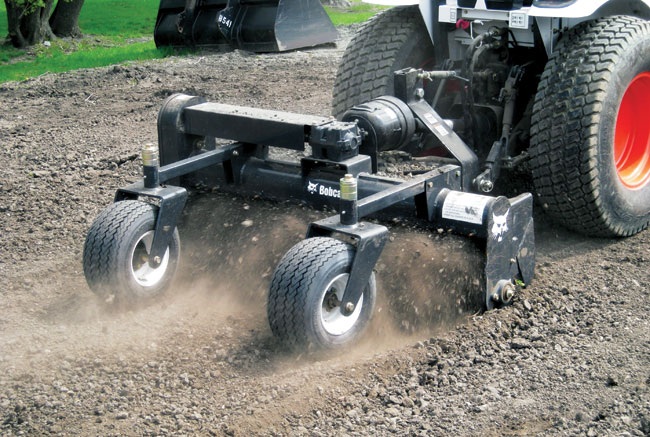Ground Forces
For a contractor or landscaper, soil conditioner attachments and implements can increase your importance on a new construction or installation site. Whether tearing out old sod, grading topsoil, pulverizing dirt clumps or preparing seed/sod beds, professionals will appreciate the power and versatility of the three-point soil conditioner and compact tractor combination.
“Bobcat offers two three-point soil conditioners in working widths of 60 and 72 inches,” Miller says. “The soil conditioner is a useful tool for producing a perfect bed for seed or sod, windrowing and separating rocks or other ground debris, grading and leveling topsoil, removing old sod or pulverizing clumps of dirt.”

The drum of the soil conditioner is powered by the rear PTO on the compact tractor, and drum rotation is set for proper operation of the soil conditioner when the machine is traveling in the forward direction. Carbide-tipped teeth cultivate the ground to produce a smooth finish. Various cutting depths are available by adjusting the rear bolster wheels. A hydraulic or manual drum angle is available on most soil conditioner models, and the drum angles 15 degrees left or right. The hydraulic angle option requires the machine to be equipped with rear auxiliary hydraulics. This option provides the operator with the convenience of being able to angle the soil conditioner without having to leave the operator area.
“If a contractor needs to prep an area for sod or seed, a soil conditioner implement is perfect for busting up the larger chunks of soil and removing rocks,” Miller says. Soil conditioners can be used to cut swales on a jobsite or in a backyard to divert water away from a house to the street or a decorative body of water located on the property. The faster the oscillation of the implement’s front wheels, the better the swale-cutting ability over rough terrain.
Removable end plates make the implement a versatile tool. When the end plates are attached to the implement, material is contained within to sort it from the finished area or to move it from one area to another. With the end plates removed, material can be spread evenly across the work area.
Another useful task is conditioning soil after a rainstorm to help dry out the landscape and ensure work on the jobsite can continue quickly. Conditioning is also necessary for turning over gravel yards and driveways. Once the site is prepped, grading can begin. In a commercial setting, dirt that will not be used for landscaping or grading should be hauled away. If there is no landscape or grading plan, the lot should be graded so that water will run away from the house and toward the street (not toward a neighbor’s property).
“Grading a jobsite happens in several stages from the initial, rough grade to the final or finished grade,” Miller explains. “A soil conditioner implement can handle grading, from start to finish.”
Christina Schave is a technical writer with Two Rivers Marketing, based in Des Moines, Iowa.
